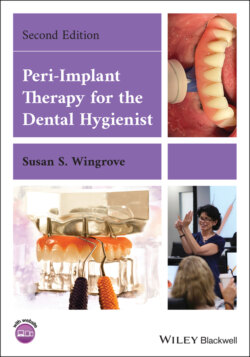Читать книгу Peri-Implant Therapy for the Dental Hygienist - Susan S. Wingrove - Страница 17
Dental implant history timeline
ОглавлениеAncient history: Mayans back in AD 600 had dental implants made from pieces of shell and ancient Egyptians used shells and ivory.
1700s: Lost teeth were often replaced with teeth from human donors. The process was mostly unsuccessful due to immune system reactions to the foreign material.
1800s: Researchers fabricated gold, platinum, and other metal alloys, including lead, into posts that were placed into the sockets of extracted teeth and donor teeth were attached after a healing period.
1886: Dr. Edmunds was the first in the United States to implant a porcelain crown mounted on a platinum disc and presented at the First District Dental Society of New York.
1913: Dr. E.J. Greenfield, pioneer of endosseous implant, provided many of the basic concepts of the nascent field of implantology. He was most known for his patented hollow‐cylinder implants made of wires soldered with 24 karat gold and outlined surgical implant placement technique (Figure 1.4).
1939: Dr. A.E. Strock introduced the first biocompatible material, the metal alloy Vitallium, to place a series of implants at Harvard University in animals and humans. He is credited with the first relatively long‐term successful dental implants.
1941: Dr. Gustav Dahl of Sweden is credited with the development of the subperiosteal implant, a metal framework that is surgically placed on top of the jawbone for completely edentulous patients (Figure 1.5).
Figure 1.4 Dr. Greenfield's basket design.
Greenfield (3).
Figure 1.5 Dr. Dahl subperiosteal design.
1952: Professor Per‐Ingvar Brånemark discovered that titanium components can bond irreversibly with living bone tissue and coined the term osseointegration.
1964: Commercial grade pure titanium, or commercial pure titanium, was accepted as material of choice for dental implants.
1967: Dr. Leonard Linkow of New York developed the blade implants and Doctors Ralph and Harold Roberts are also credited with the development of endosteal implants (Figure 1.6).
1968: Dr. Irwin Small developed the transosteal dental implant (Figure 1.7).
1969: Dr. Per‐Ingvar Brånemark provided the proof of long‐term success of titanium implants.
1981: Dr. Per‐Ingvar Brånemark published his findings covering all the data on the animal and human clinical trials: success rate, concept, and the current design of endosteal root‐form titanium implants.
1982: The Toronto Conference on Osseointegration in Clinical Dentistry created the first guidelines for what would be considered the standardization of successful implant dentistry.
1986: Implants received the endorsement of the American Dental Association (ADA).
1989: The Brånemark Osseointegration Center (BOC) in Gothenburg, Sweden, was founded. BOC's primary mission was to provide treatment for patients with severe oral, maxillofacial, and orthopedic impediments.
2002: An ADA survey showed that oral and maxillofacial surgeons, periodontists, and general dentists doubled the number of implants performed per dentist between 1995 and 2002.
Today: The Food and Drug Administration (FDA) regulates the oral and dental implants being placed, requiring implant companies to furnish data and controlled studies under medical devices to gain full approval.
Figure 1.6 Endosteal design.
Juodzbalys and Wang (21).
Figure 1.7 Transosteal design.
Reprinted with permission from Zwemer (22) © 2008 Elsevier, Inc. All rights reserved.
